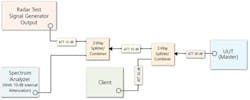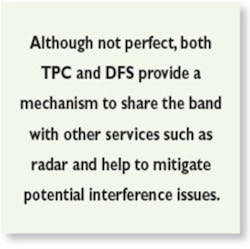Using cognitive-type radio features to help share frequency bands between various services is gaining popularity in the United States. Two of these features are transmitter power control (TPC) and dynamic frequency selection (DFS).
The requirements for DFS can be found in ITU-R Resolution 229, which addresses dedicating the 5,150- to 5,350-MHz and 5,470- to 5,725-MHz bands for mobile systems. This allocation on a noninterference basis includes wireless access systems including Radio LAN (RLAN).
DFS and TPC
To facilitate band sharing in these frequencies, the FCC was required to adopt DFS and TPC techniques as referenced in the ITU-R Resolution 229. The FCC describes TPC as �a feature that enables an Unlicensed National Information Infrastructure (U-NII) device to dynamically switch between several transmission power levels in the data transmission process.� It also defines transmit power as �the total energy transmitted over a time interval of at most 30/B (where B is the 26-dB emission bandwidth of the signal in hertz) or the duration of the transmission pulse, whichever is less, divided by the interval duration.�
The FCC requires the U-NII device to operate at least 6 dB below the mean equivalent isotropically radiated power (EIRP) value of 30 dBm.
The FCC describes DFS as having two key functionalities:
� To ensure uniform channel loading across the frequency bands in question. This helps mitigate the chances of interference in the band.
� To detect a radar signal and then move off channel to avoid interfering with the radar.
Basically, DFS functionality performs an availability check before using the channel and then listens in the quiet periods to determine if a radar signal is present. If a radar signal is present on a given channel, the master device, which has DFS capabilities, issues a control signal and moves the clients off that channel to avoid interfering with the radar.
It seems simple enough, but there are pitfalls. If the WLAN cannot distinguish between a real radar signal and another WLAN signal, it may move off channel by mistake. To avoid this problem, the industry must develop detection algorithms that can distinguish between a radar signal and a WLAN signal in its own network.
Systems that operate in the 5,250- to 5,350-MHz and 5,470- to 5,725-MHz bands must use DFS. Systems in the 2,400-MHz band, the 5,150- to 5,250-MHz band, and the 5,725- to 5,825-MHz band are not required to use DFS.
DFS Detection Threshold
The DFS detection thresholds are referenced to ITU-R Resolution 229 and have been incorporated in various regulations around the world. The detection thresholds were based on technical studies done prior to the World Radio Conference 2003.
The actual limits adopted as part of the WRC2003 were based on the compromise between the manufacturers and the U.S. government. The DFS detection thresholds are defined as -64 dBm for wireless access system (WAS) devices with EIRP between 200 mW and 1 W and -62 dBm for WAS devices with EIRP less than 200 mW.
As part of the detection criteria, the system must meet additional operating parameters. First is the actual listening time when the device comes up on a particular channel. Once a radar signal is detected, then there is a maximum time allowed before it must clear the channel and a specific amount of time it cannot use a channel once a radar signal is detected (Table 1).
Verifying DFS Worked
The test procedure developed to verify if DFS works requires the system to detect three different radar signals over various periods: short pulse, long pulse, and frequency hopping based radar signals. One key issue was agreeing on the detection thresholds of the various radar devices. Again, this compromise was worked out between the manufacturers and the U.S. government (Figure 1).
Several sets of test trials were performed to verify that the test procedure actually could verify the parameters as defined in the ITU-R resolution and the FCC Part 15 rules.
Where possible, the procedures were harmonized with the European Telecommunications Standards Institute (ETSI) procedures to test DFS. The main distinctions between the two test methods are the differences regarding certain types of radar parameters that we test for in the United States. In parallel efforts, the WLAN manufacturers developed products that could meet those requirements.
Once it was established that the test procedure could verify the DFS detection limits and operational characteristic and that the hardware worked, we moved to the next phase. This phase was to determine if DFS actually would detect real-world radar.
In mid December 2005, the National Telecommunications and Information Administration (NTIA) tested several manufacturers� systems detection capabilities against several U.S. radars. This testing, performed at a military base, demonstrated that the systems that passed the DFS criteria test requirements could, in fact, detect the radar in question.
There has been interest in several recent FCC proceedings to require DFS capabilities for sharing other bands. The requirements for DFS detection levels as well as the test methodology were developed to allow sharing the 5,000-MHz bands with the primary and secondary services in those bands.
Going Forward
Although the concept of DFS will work for band sharing, new detection parameters and test conditions must be developed for the particular band and services in the band that you are planning to share. Not only will this take effort from the regulators, but also from the incumbents in the band and those wanting to share the band with other services.
It must be noted that the DFS functionality developed today is based on sharing studies between certain types of radar in the 5,000-MHz band and WLAN devices. If, for example, we opted to use this technique in the 3,650-MHz band, new studies would have to be completed to determine issues such as threshold detection level, monitoring time, and listening time.
Based on these studies, new algorithms and detection mechanisms for the wireless devices would need to be developed. In addition, the test procedures themselves would need modification to address any changes required based on the studies and hardware.
Conclusion
Although not perfect, both TPC and DFS provide a mechanism to share the band with other services such as radar and help to mitigate potential interference issues.
As these types of cognitive radio techniques are used, it will take players on both sides of the aisle, including current users and those who want to share the band, to work together. And, as with the current DFS issue, it will take time and patience to reach a satisfactory conclusion.
About the Author
David A. Case, NCE, NCT, is a senior regulatory engineer for Cisco Systems Corporate Compliance Group. He is a member of a number of technical committees addressing spectrum issues, test methodology, and technical standards. Mr. Case also holds membership in the ITAC-R committee that helps draft the U.S. DFS test procedure. Cisco Systems Corporate Compliance, 4125 Highlander Parkway, Richfield, OH 44286, 330-523-2139, e-mail: [email protected]
FOR MORE INFORMATION
on cognitive radio
www.rsleads.com/702ee-184
February 2007



